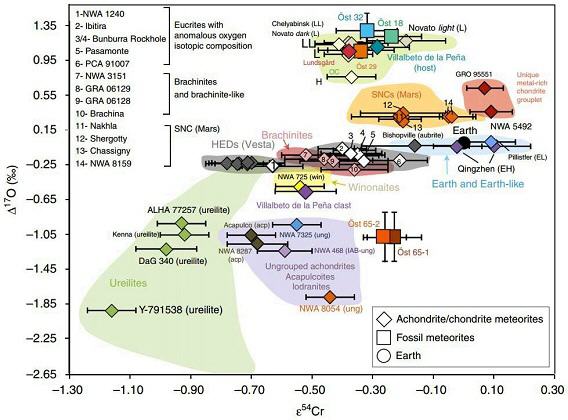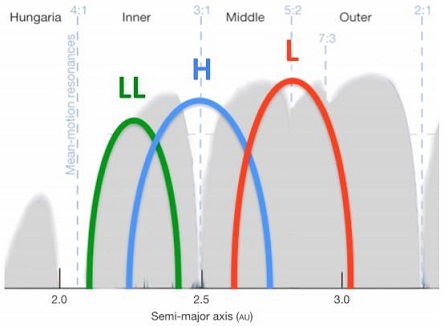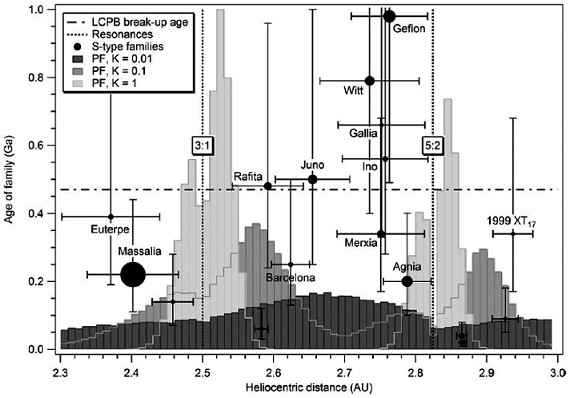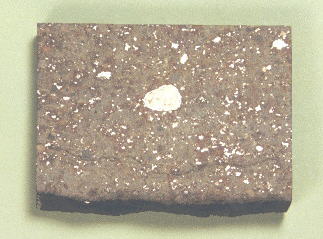Beenham
L5
Found 1937
36° 13′ N., 103° 39′ W. Many individual stones and fragments of this meteoriteWork in progress. A solid natural object reaching a planet’s surface from interplanetary space. Solid portion of a meteoroid that survives its fall to Earth, or some other body. Meteorites are classified as stony meteorites, iron meteorites, and stony-iron meteorites. These groups are further divided according to their mineralogy and Click on Term to Read More were recovered in township 25, range 30E., in Union County, New Mexico, which is a very arid region. The total recovered weight was 44.4 kg.
| Chromite Diameter vs. Petrologic Type |
|
|---|---|
| Diameter (µm) | |
| L3 | 34–50 |
| L4 | 87–150 |
| L5 | 76–158 |
| L6 | 253–638 |
Although this method of discrimination among petrologic types is not absolute, it serves to illustrate the approximate range of petrologic types represented by the fossil meteorites from the mid-Ordovician Swedish marine limestone quarries. It was determined that a greater percentage of low petrologic types are present in the quarries compared to the percentages represented by recent L-chondrite falls, possibly reflecting differences in the nature of the ejected material (Bridges et al., 2007).
Utilizing a new method to resolve the chondriteChondrites are the most common meteorites accounting for ~84% of falls. Chondrites are comprised mostly of Fe- and Mg-bearing silicate minerals (found in both chondrules and fine grained matrix), reduced Fe/Ni metal (found in various states like large blebs, small grains and/or even chondrule rims), and various refractory inclusions (such Click on Term to Read More group to which these fossil meteorites derive, Alwmark and Schmitz (2009) studied relict chromite grains from fossil meteorites recovered in the Thorsberg quarry (Österplana) and Gärde quarry (Brunflo), as well as grains recovered from sediment samples from similar quarries. They studied <1–15 µm-sized olivineGroup of silicate minerals, (Mg,Fe)2SiO4, with the compositional endpoints of forsterite (Mg2SiO4) and fayalite (Fe2SiO4). Olivine is commonly found in all chondrites within both the matrix and chondrules, achondrites including most primitive achondrites and some evolved achondrites, in pallasites as large yellow-green crystals (brown when terrestrialized), in the silicate portion Click on Term to Read More, pyroxeneA class of silicate (SiO3) minerals that form a solid solution between iron and magnesium and can contain up to 50% calcium. Pyroxenes are important rock forming minerals and critical to understanding igneous processes. For more detailed information, please read the Pyroxene Group article found in the Meteoritics & Classification category. Click on Term to Read More, and other inclusionFragment of foreign (xeno-) material enclosed within the primary matrix of a rock or meteorite. Click on Term to Read More types that are encapsulated in chromite grains, and discovered that for many of these mineralInorganic substance that is (1) naturally occurring (but does not have a biologic or man-made origin) and formed by physical (not biological) forces with a (2) defined chemical composition of limited variation, has a (3) distinctive set of of physical properties including being a solid, and has a (4) homogeneous Click on Term to Read More inclusions the primary compositions have been retained, thus enabling these chromite inclusions to be employed as an additional classification method. Despite the fact that extensive sub-solidus re-equilibration of these silicateThe most abundant group of minerals in Earth's crust, the structure of silicates are dominated by the silica tetrahedron, SiO44-, with metal ions occurring between tetrahedra). The mesodesmic bonds of the silicon tetrahedron allow extensive polymerization and silicates are classified according to the amount of linking that occurs between the inclusions has occurred over hundreds of thousands of years, resulting in their having a higher content of Cr and a lower Fe/Mg ratio, a comparison was still able to be made between these relict inclusions and analogous inclusions in chromite grains from recent chondrites. It was demonstrated that the Fa and Fs values associated with the fossil chromite host meteorite are all consistent with an L chondriteOrdinary chondrites low in free Ni-Fe metal (4 to 10 vol. %), containing olivine (Fa22-26) and the orthopyroxene hypersthene (Fs19-22). Average chondrule diameters (0.7 mm) are larger than those in H chondrites. The asteroid 433 Eros is suspected as a parent body, based on reflectance spectra, but most L chondrites Click on Term to Read More heritage. Moreover, Heck et al. (2009) found that the elemental compositions of the chromite grains they analyzed were consistent with those of modern L chondrites. The age of the meteorites found in these quarries has been precisely established in accord with the Geologic Time Scale 2004 to be 467.3 (±1.6) m.y., based on the appearance of certain species of early marine conodonts. In addition, an anomalously high volume of extraterrestrial chromite grains was found during a search of sediments within this 3.2 m stratigraphic interval. This interval represents 1–2 m.y. of accumulation, and the initial count indicated a 100-fold increase in the meteorite flux during this specific period (Schmitz et al., 2003). A subsequent thorough study was conducted at the Vernadsky Institute in Russia (V. A. Alexeev, 2014) to ascertain the abundances of both extraterrestrial and terrestrial sediment-dispersed chromite grains that are present in these stratographic layers at the various quarries. The results indicate that the actual increase in extraterrestrial chromite grains compared to those of terrestrial origin was only a factor of ~3–4. In 2001, workers at the Thorsberg quarry discovered a single fossil meteoriteThe textural, mineralogical or compositional remnant within a sedimentary rock of a meteorite that fell millions of years ago and found in Ordovician limestone from Sweden. Read Tiny Traces of a Big Asteroid Breakup for a complete writeup on this subject. In picture to the left a nautiloid shell is Click on Term to Read More, designated Gla3 003 and measuring 8 × 6.5 × 2 cm, that was located in the uppermost bed; this meteorite was different from all of the other L-chondrite fossils (Schmitz et al., 2014, 2016). This fossil meteorite, classified as Österplana 065 (previously designated ‘the mysterious object’), was initially determined to be most similar to winonaites, although it had a number of unique characteristics. Its O-isotopic value plots along the trend for winonaites which suggests formation within a common reservoir, and its elemental ratios compare reasonably well with this group as well. Notably, a xenolithic inclusion from the L6 chondrite Villalbeto de la Peña shares similar isotopic and compositional characteristics with this unusual fossil meteorite. Schmitz et al. (2016) conducted Cr-isotopic analyses of Österplana 065, three fossil L chondrites (Österplana 018, 029, and 032), and the Villalbeto de la Peña clastA mineral or rock fragment embedded in another rock. Click on Term to Read More, as well as chrome-spinel grains from both the winonaitea partially differentiated asteroid that was disrupted just as it began to form an Fe core and a silicate-rich crust. This disrupting impact mixed silicates into molten Ni-Fe metal forming the silicated IAB irons, and mixed olivine-rich residues of partial melts into unmelted silicates, forming the winonaites. A few winonaites Click on Term to Read More NWA 725 and the L6 chondrite Lundsgard. In addition, they determined more precise oxygen isotopes for chrome-spinel grains from Österplana 065. They demonstrated through a coupled Δ17O vs. ε54Cr diagram (shown below) that Österplana 065 plots in a distinct location in isotopeOne of two or more atoms with the same atomic number (Z), but different mass (A). For example, hydrogen has three isotopes: 1H, 2H (deuterium), and 3H (tritium). Different isotopes of a given element have different numbers of neutrons in the nucleus. Click on Term to Read More space, indicating that it derives from a unique, possibly extinct parent body not otherwise represented in our collections. In addition, it was shown that the Villalbeto de la Peña clast plots with NWA 725 in the winonaite field. Österplana 065 Chromium vs. Oxygen Isotope Plot
click on image for a magnified view Diagram credit: Schmitz, B. et al., Nature Communications, vol. 7, p. 4 (2016, open access link)
‘A new type of solar-system material recovered from Ordovician marine limestone’
(https://doi.org/10.1038/ncomms11851) Österplana 065 has the same gas retention age as the other L chondrites of 470 m.y., and its CRE age of ~1 m.y. matches that of chromite grains derived from the fossil L chondrites from the same uppermost strataOriginally horizontal layers of rock. in the quarry. The chrome-spinel grains in Österplana 065 exhibit abundant planar shock features comparable to chromite in some highly shocked L chondrites with a shock stageA petrographic assessment, using features observed in minerals grains, of the degree to which a meteorite has undergone shock metamorphism. The highest stage observed in 25% of the indicator grains is used to determine the stage. Also called "shock level". Click on Term to Read More of S4–S6 (Rout et al., 2017, 2018). These facts along with other evidence indicate that Österplana 065 is likely associated with the same catastrophic breakup event as the L6 chondrites, and it was conjectured that this unique meteorite could represent the impactor that disrupted the L chondrite parent body 470 m.y. ago. Interestingly, Martin and Schmitz (2016) have identified a chrome-spinel grain that has an elemental composition similar to chrome spinelMg-Al oxide, MgAl2O4, found in CAIs. grains from the Österplana 065 fossil meteorite. This grain was among over 500 extraterrestrial grains collected and analyzed from 100 kg of rock obtained from the Komstad Limestone Formation in Killeröd, Scania, Sweden; this location has proven to be exceptionally rich in chromite grains associated with the L-chondrite breakup event. Heck et al. (2017, #1694) conducted a further study of relict grains deposited in sediments at the Lynna River in Russia 467 m.y. ago (prior to the L-chondrite breakup event). Employing a coupled Δ17O vs. TiO2 diagram, they identified a single chrome-spinel grain which plots in compositional space similar to Österplana 065. <img src='https://skyfallmeteorites.com/wp-content/uploads/images/dweir/Oster065.jpg' A significant number of chromite grains recovered from the Sextummen bed at the Thorsberg quarry were found to contain solar-wind-implanted Ne and He (Meier et al., 2008). This finding provides positive evidence that the chromite grains did not permeate the meteorite before its delivery to Earth only to be released into the limestone sediments by the action of terrestrial weathering processes. Rather, the chromite grains were established initially as particles comprising one to several ~100-µm-sized grains at the time of parent body breakup, becoming solar gas rich during their rapid transitWhen a small celestial body moves in front of a much larger one (as when Mercury or Venus appears in silhouette against the solar disk or when a satellite passes in front of Jupiter or Saturn). The shadow of a satellite may also transit the disk of its primary. and delivery to Earth (Heck et al., 2008). Studies of chromite grains from contemporary mid-Ordovician limestone beds in both China (Alwmark et al., 2012) and northwestern Russia (Lindskog et al., 2012) have demonstrated that the same high concentrations exist and contain similar implanted solar Ne, attesting to a global accretionAccumulation of smaller objects into progressively larger bodies in the solar nebula leading to the eventual formation of asteroids, planetesimals and planets. The earliest accretion of the smallest particles was due to Van der Waals and electromagnetic forces. Further accretion continued by relatively low-velocity collisions of smaller bodies in the Click on Term to Read More from the breakup of the L-chondrite parent body 470 m.y. ago. Cosmic ray exposure ageTime interval that a meteoroid was an independent body in space. In other words, the time between when a meteoroid was broken off its parent body and its arrival on Earth as a meteorite - also known simply as the "exposure age." It can be estimated from the observed effects Click on Term to Read More measurements of the fossil meteorites based on cosmogenic 21Ne indicate that their ages correspond to their recovered depth within the sediment, with longer CRE ages found in the younger strata (Heck et al., 2004). It was determined that these meteorite samples arrived on Earth within one to several hundred thousand years after parent body breakup. By considering both solar and galactic cosmic-rays, a very approximate 21Ne-based CRE age was calculated for the chromite grains, with an age of 0.046–9.6 m.y. considered as the best estimate. Extensive analyses of cosmogenic noble gasesElement occurring in the right-most column of the periodic table; also called "inert" gases. In these gases, the outer electron shell is completely filled, making them very unreactive. Click on Term to Read More in these chromite grains, compared to those in fossil meteorites recovered from similar quarries, have demonstrated that the CRE ages are comparable and significantly lower than those of recently fallen L chondrites. A catastrophic breakup of an asteroid would have rapidly injected fragments into a nearby strong orbital resonanceDynamic relationship between bodies in heliocentric orbits in which a small body has an orbital period that is a simple fraction of a nearby larger body such as Asteroid Belt objects and Jupiter. The periodic gravitational tug of the large body induces changes in the orbit of the smaller body Click on Term to Read More such as the Jupiter 5:2 mean motion resonance at ~2.82 AUThe astronomical unit for length is described as the "mean" distance (average of aphelion and perihelion distances) between the Earth and the Sun. Though most references state the value for 1 AU to be approximately 150 million kilometers, the currently accepted precise value for the AU is 149,597,870.66 km. The Click on Term to Read More, which would provide very short transit times from the inner asteroid beltBelt located between 2.12 and 3.3 AU from the Sun and located between the orbits of Mars and Jupiter containing the vast majority of asteroids. The asteroid belt is also termed the main asteroid belt or main belt to distinguish it from other asteroid populations in the Solar System such Click on Term to Read More to Earth in a matter of 50 t.y. to 2 m.y. (Bottke et al., 2009). According to their model, recent delivery of this shocked L chondrite material from the main beltBelt located between 2.12 and 3.3 AU from the Sun and located between the orbits of Mars and Jupiter containing the vast majority of asteroids. The asteroid belt is also termed the main asteroid belt or main belt to distinguish it from other asteroid populations in the Solar System such Click on Term to Read More to Earth-crossing orbits would occur through the more efficient Jupiter 3:1 mean motion resonance in 5–100 m.y. (most in 30–40 m.y.). In addition, orbital decay via the Poynting–Robertson drag mechanism would likely assist the rapid transit of chromite dust grains to Earth (Heck et al., 2008). An increase in the cratering rate on Earth at this time may be apparent, but craterBowl-like depression ("crater" means "cup" in Latin) on the surface of a planet, moon, or asteroid. Craters range in size from a few centimeters to over 1,000 km across, and are mostly caused by impact or by volcanic activity, though some are due to cryovolcanism. Click on Term to Read More ages need to be better resolved before a definite association can be established. Although the Gefion family was once considered a plausible source of L chondrites due to the timing of breakup and to its proximity to efficient resonances, recent VNIR spectra of 11 Gefion family asteroids show that a mixture of chondrite types are present (Roberts et al., 2015). In a subsequent NIR spectral study of five Gefion family asteroids, McGraw et al. (2017) employed laboratory spectral calibrations to ascertain that two of them (1839 Ragazza and 2521 Heidi) have silicate compositions similar to H-chondrites, two of them (2386 Nikonov and 3860 Plovdiv) are similar to an acapulcoite–lodranite-like primitive achondriteAchondrite with an almost chondritic composition with age similar to the primordial chondrites. These should be better classified as "metachondrites"., and one (2373 Immo) is similar to an HED-like basaltic achondriteAn achondrite is a type of stony meteorite whose precursor was of chondritic origin and experienced metamorphic and igneous processes. They have a planetary or differentiated asteroidal origin where the chondritic parent body reached a sufficient size that through heating due to radioactive decay of 26Al (aluminum isotope) and gravitational Click on Term to Read More. Based on new noble gasElement occurring in the right-most column of the periodic table; also called "inert" gases. In these gases, the outer electron shell is completely filled, making them very unreactive. Click on Term to Read More and cosmogenic nuclideA nuclear species characterized by Z protons and N neutrons. Click on Term to Read More analyses, as well as dynamical modeling, Meier et al. (2017) assert that the location of the L chondrite parent body at the time of breakup was near the Jupiter 5:2 mean motion resonance (signifying the ratio between the orbital periodThe length of time it takes an orbiting object to make one complete trip around its primary body. The Earth’s orbital period around the Sun is 1 year and the Moon's is one 27.3 days. Mercury's orbital period is ~88 days (closest to the Sun) and Neptune's is ~165 years Click on Term to Read More of Jupiter and that of an asteroid) from which rapid delivery from the inner asteroid belt to an Earth-crossing orbitThe elliptical path of one body around another, typically the path of a small body around a much larger body. However, depending on the mass distribution of the objects, they may rotate around an empty spot in space • The Moon orbits around the Earth. • The Earth orbits around Click on Term to Read More could be attained, consistent with the CRE age calculated for the fossil L chondrites recovered from mid-Ordovician limestone quarries. Based on spectrographic and mineralogical data for more than 1,000 near-Earth asteroids, Binzel et al. (2016) determined the probable main belt source region for each of the ordinary chondriteWork in Progress Ordinary chondrites (OCs) are the largest meteorite clan, comprising approximately 87% of the global collection and 78% of all falls (Meteoritical Society database 2018)1. Meteorites & the Early Solar System: page 581 section 6.1 OC of type 5 or 6 with an apparent shock stage of S1, Click on Term to Read More groups (see diagram below).

Diagram credit: Binzel et al., 47th LPSC, #1352 (2016) Thereafter, L chondrite material would have been delivered to the more efficient, albeit slower, 3:1 mean motion resonance at 2.50 AU (and the less important ν6 secular resonance) where transfer to Earth occurred over an extended period of millions of years. In consideration of such factors as pre-breakup size, breakup age, and shock-darkening history of the parent asteroid, they contend that the Ino asteroid family may be a more plausible source than the Gefion family (see the Park Forest page for further details).

Diagram credit: Meier et al., MAPS, vol. 52, p. 1569 (2017)
‘Park Forest (L5) and the asteroidal source of shocked L chondrites’
(http://dx.doi.org/10.1111/maps.12874) At least one further impact event on the L-chondrite parent body is recorded ~20 m.y. ago, which produced abundant fragments and caused severe shock effects and significant radiogenic gas loss. A portion of the fragments eventually found their way into Earth-crossing resonances, and they are currently one of the most well represented meteorite groups seen to fallMeteorite seen to fall. Such meteorites are usually collected soon after falling and are not affected by terrestrial weathering (Weathering = 0). Beginning in 2014 (date needs confirmation), the NomComm adopted the use of the terms "probable fall" and "confirmed fall" to provide better insight into the meteorite's history. If Click on Term to Read More. The specimen of Beenham shown above is a 29.0 g partial slice with a large troiliteBrass colored non-magnetic mineral of iron sulfide, FeS, found in a variety of meteorites. Click on Term to Read More inclusion at its center.
For additional information on these fossil meteorites, read these PSRD articles:
‘Tiny Traces of a Big Asteroid Breakup‘, by Linda M. V. Martel, March 2004
‘Searching for Ancient Solar System Materials on the Moon, Earth, and Mars‘, by G. Jeffrey Taylor, November 2016







